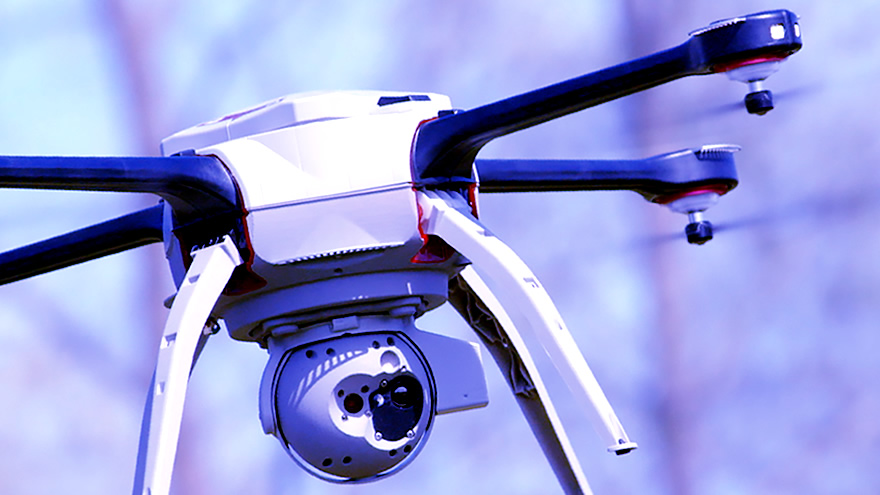
One area that promises to provide great impetus to the growth of the Mobile Cloud is the surging business of drones. Encompassing the widest imaginable range of unmanned airborne vehicles (UAVs, also called UASs, unmanned aerial systems), this segment is going to continue to experience growth across a slew of categories from heavy-duty military weapons and support, to tiny personal aerial-borne devices
One of the companies strongly on the move is Canadian-based Aeryon Labs. We recently spoke with David Proulx, VP, Product and Marketing for Aeryon. He told us that the 120-person company, plans to double in size in the next year – this growth being supported in part by a recent $60 million capital injection from leading private equity firm, Summit Partners.
Key Markets Military, Public Safety, Commercial
The company focuses on three market segments: military, public safety and high-end commercial applications. It is offering one drone at this time, the SkyRanger.
There’s various terminology and acronyms used in what is popularly referred to as the drone area. Aeryon calls the four-rotor SkyRanger a sUAS, or “small unmanned aerial system.” The acronym UAV, unmanned aerial vehicle, is also common.
One of the outstanding features of the SkyRanger, Proulx points out, is durability and capability to perform in very poor weather conditions. “It can operate in dust or snow conditions,” he states. It can stay aloft for up to 50 minutes with its payload, can tolerate winds of 40 mph and gusts of 55 mph, and perform in temperatures ranging from -22ºF to 120ºF. It has a range of 1.9 miles beyond line-of-sight and provides 256 bit AES encryption for transmissions.
This makes it highly suitable for a range of military requirements, in tactical ISR (Intelligence, Surveillance, and Reconnaissance). The system is also light – 5.3 pounds, plus payload – can be carried in a backpack and assembled quickly by a single operator. Control is through a touch screen, rather than a joystick.
Proulx states that they believe they are the preeminent supplier of VTOL (vertical takeoff and landing) unmanned vehicles in the Group 1 category of the military. (Group 1 is a category defined by the U.S. Military that covers smaller, up to 20 pounds, UASs.) Proulx states that Aeryon has “a couple of dozen military customers, throughout the world.”
Public Safety Business Expansion
The military was an early source of business for the company and Proulx reports that it still represents about 50% of revenues. However, the company has been expanding strongly into the public safety and commercial segments.
Recently, it attracted attention when it was selected by Microsoft to be the airborne adjunct for a system that Microsoft is making available for police, called the Microsoft Advanced Patrol Platform (MAPP). Proulx explains that MAPP is basically a demonstration platform for state of the art data capture and processing capabilities for police that will be tied into Microsoft’s Azure cloud.
Drones are growing in acceptance among law enforcement agencies, Proulx points out, largely because of the high cost of manned aerial surveillance. “Small aerial systems can help police in SWAT situations, search and rescue and even by providing high resolution photos of accident scenes,” he states.
Aeryon has been selling to law enforcement and other public safety agencies, first responders, fire fighters, and the like, for several years.
Commercial – Most Appealing Growth Area
Proulx regards the commercial segment as offering the greatest growth potential for the company’s established business. Proulx singles out applications where the UASs will mitigate serious risks or high costs. One example is inspection of electric utility outside plant facilities where workers must climb towers wearing harnesses or manned aerial inspection is a costly alternative. Another is inspection of a flare stack (used for gas flaring at many oil and gas production sites), where inspection would otherwise require shutting down the facility.
Key commercial areas for the company include: energy/oil and gas, utilities, agriculture, wild life management.
The SkyRanger is offered with a number of payloads for different types of HD imaging, video, mapping and infrared imaging. The vehicle will also accommodate custom designed payloads such as air sensing devices – carbon dioxide and methane detectors. It captures data such as temperature and barometric readings.
Beyond Drone Vehicles – Analytics
For future growth, the company is looking beyond just the physical features and data capture capabilities of UASs. “We believe we have the market segmentation right and are committed to the areas we are now in,” Proulx explains. “We are looking at a broadened role, beyond airborne data capture.”
This could include fleet management of both vehicles and operators, networking and data distribution, information storage, analytics and presentation. This all leads down the path of Big Data, the Cloud and Analytics. As Proulx puts it, “If someone is inspecting a pipeline, you can’t just hand them gigabytes of data.” He indicates that this will also lead them to consider various partnerships in the verticals that they are interested in.
The UAV area has been estimated at about a $10 billion market as of 2015. It is still dominated by military – 80% or more – with the U.S. military market estimated to be growing at about 12% per year (per Market Research Media study.) The enterprise market is growing off a smaller base, $600+ million, and is expected to grow more quickly, around 17% per annum (per Teal Group.) Our take is that Aeryon, with a major new capital investment, appears to be positioned for very strong growth, which should be augmented if it can successfully develop its data analytics programs.
Visit their website: www.aeryon.com
